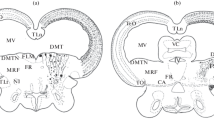Summary
In the course of our study on Wallerian degeneration in the young rat optic nerve after unilateral enucleation, cell proliferation was measured by quantitative radio-autography. Ninety-two newborn rats were separated into four groups which were operated at 2, 5, 8 and 20 days postnatal (key stages) respectively. In each of these groups, the animals were sacrificed after progressive delays ranging from 3 h to 30 days (DPO). They received, 3 h before the sacrifice, an intraperitoneal injection of 2 μCi/g weight of tritiated thymidine. After the radio-autographic procedure, semi-thin sections were examined, and labeled as well as unlabeled cells were counted on the whole cross section of the operated nerve, as well as on the contralateral nerve. In the operated nerve, the four key stages may be separated into two reactive patterns, depending on whether the enucleation is performed before or after the myelination gliosis. The two first key stages (2 and 5 DPN) show leveling down of the curve of their proliferative indices, when compared with the control, whereas the two other key stages (8 and 20 DPN) showed a leveling up of the curve. The comparison of these data with those of previous work (Fulerand and Privat, 1977; Valat et al., 1978) permitted the evaluation of cell death, which is specially evident at the key stage 8 DPN. The proliferative ability of neuroglial cells thus appear no to be closely dependent upon an intrinsic genetic program, but rather to be modulated by epigenetic events. The early absence of the axonic signal induces a decrease of this proliferation, whereas the more or less belated interruption of the same signal induces a reactive gliosis, with a net increase of proliferative indices over the control.
Similar content being viewed by others
References
Adrian, E. K., Jr.: Cell division in injured spinal cord. Am. J. Anat.123, 501–520 (1968)
Fulerand, J., Marty, R.: Migrations névrogliques dans le tractus optique chez le Rat. Radio-autographie quantitative au cours du développement postnatal. Exp. Brain Res.14, 38–47 (1971)
Fulerand, J., Privat, A.: Neuroglial reactions secondary to Wallerian degeneration in the optic nerve of the postnatal rat: ultrastructural and quantitative study. J. Comp. Neurol.176, 189–224 (1977)
Fulerand, J., Valat, J., Marty, R.: Maturation et réactions névrogliques dans les voies optiques primaires: étude postnatale chez le Rat. VIIè Congrès International de Neuropathologie, Budapest, pp. 733–735, Amsterdam: Excerpta Medica 1975
Hattori, H.: Electron microscopic autoradiographic studies on the origin, nature and fate of reactive cells in the central nervous system of mouse after stab-wounding. J. Kyoto Pref. Univ. Med.82, 403–426 (1973)
Herndon, R. M., Weiner, L. P., Price, D. L.: Thymidine labeling of glia during remyelination after J. H. M. injection. Abstract 51th Meet. Amer. Ass. Neuropath. 1978, 108
Kerns, J. M., Hinsman, E. J.: Neuroglial response to sciatic neurectomy. I: light microscopy and autoradiography. J. comp. Neurol.151, 237–254 (1973)
Kreutzberg, G. W.: Autoradiographische Untesuchung über die Beteiligung von Gliazellen an der axonalen Reaktion im Facialiskern der Ratte. Acta neuropath. (Berl.)7, 149–161 (1966)
Lewis, P. D.: Cell death in the germinal layers of the postnatal rat brain. Neuropath. Applied Neurobiol.1, 21–29 (1975)
Privat, A., Fulcrand, J.: Glial reaction in the optic nerve of the young rat after unilateral enucleation. Anat. Rec.184, 505 (1976)
Reznikov, K. Y.: Incorporation de 3H thymidine dans les cellules de la névroglie du cortex temporal et dans les cellules de la zone sous-épendymaire chez des souris de deux semaines ou adultes à l'état normal ou après traumatisme cérébral (en russe). Ontogenez6, 169–176 (1975)
Schultze, B., Kleihues, P.: D.N.S. Synthese der Neuroglia im experimentellen Hirnödem. Experientia23, 941–942 (1967)
Sjöstrand, J.: Proliferative changes in glial cells during nerve regeneration. Z. Zellforsch.68, 481–493 (1965)
Skoff, R. P.: The fine structure of pulse labeled (3H thymidine cells) in degenerating rat optic nerve. J. Comp. Neurol.161, 595–611 (1975)
Skoff, R. P., Vaughn, J. E.: An autoradiographic study of cellular proliferation in degenerating rat optic nerve. J. Comp. Neurol.141, 133–156 (1971)
Valat, J., Fulcrand, J., Marty, R.: Réactivité cellulaire postnatale du nerf optique après énucléation chez le Rat. I. Aspects quantitatifs en relation avec la myelinisation. Acta Anat.100, 5–16 (1978)
Author information
Authors and Affiliations
Rights and permissions
About this article
Cite this article
Valat, J., Fulcrand, J., Privat, A. et al. Radio-autographic study of cell proliferation secondary to Wallerian degeneration in the postnatal rat optic nerve. Acta Neuropathol 42, 205–209 (1978). https://doi.org/10.1007/BF00690358
Received:
Accepted:
Issue Date:
DOI: https://doi.org/10.1007/BF00690358



